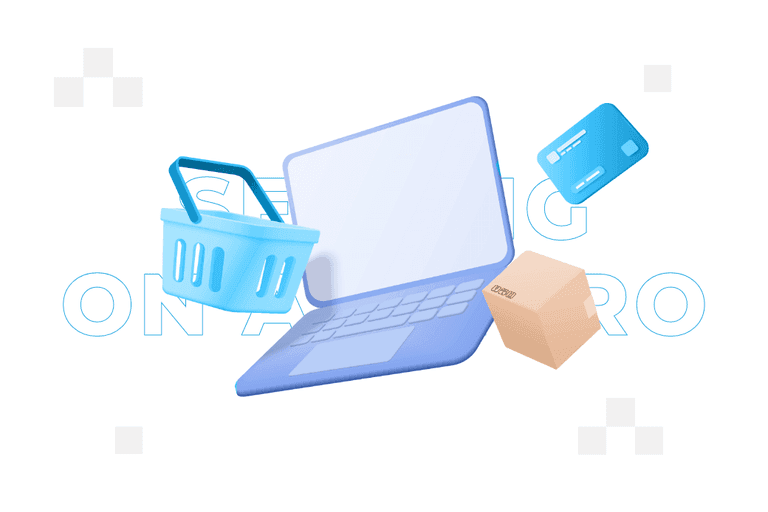
Selling on Allegro without secrets! Disadvantages, advantages, how to start and how to develop it?

We have a true E-commerce hegemon in Poland: Allegro. It is not even intimidated by big foreign competitors such as eBay or Amazon. Selling on the country’s largest “auction portal” (inverted commas, as only around 10% of all listings are actually auctions) is an opportunity for many companies to smoothly enter the market and generate stable revenues from online trading. How to start selling on Allegro and how to take it to the next level? What are the biggest disadvantages of the service and what are the advantages? What is worth knowing in order for actions on Allegro to bring the expected effect?
Bright and dark sides of Allegro
Trading on Allegro has its obvious advantages as well as disadvantages. It is worth learning about all of them before you start any sales activities on this site.
Trading on Allegro – the disadvantages
In the general opinion of the industry, Allegro is not the easiest partner or sales environment. This is primarily influenced by:
- Complicated regulatory requirements;
- The many conveniences for the consumer, which unfortunately come with additional difficulties for the seller;
- The need to fight against (not always quite fair) mass competition;
- High costs.
The fees that apply to Allegro sellers consist of, among others: commission per product sold (from 3 to 15%), listing fee, listing renewal fee and fees for promoting ads. The amount of the commission depends, among other things, on the category of the product listed.
By far the most onerous in the mix are the costs associated with promoting listings. It happens that sellers are forced to bear them due to the high competition within the service – simply their offer sinks among many other similar ones. It also doesn’t help that in some categories on Allegro, it sells… Allegro, so it’s unlikely to ever be a fair competition.
It should also be mentioned that the changes introduced by Allegro over the years are most often not particularly beneficial for sellers, but very much so for buyers. This often makes it necessary to adapt the business “month by month” to the new conditions.
Advantages and strengths of Allegro
If Allegro has numerous disadvantages and can sometimes even hinder sellers, what makes it the most popular E-commerce site in Poland after all?
- First and foremost, scale works here: the portal has at least several million active (to a greater or lesser extent) users. Millions of transactions are made on Allegro each month, totalling dizzying amounts. Displaying one’s products to such a large clientele strongly increases the chances of successful sales;
- Allegro is also easy to use. All the actions on an account literally take a moment, even for people with little technical skill. Many tools are available to sellers to assist with shipping and more;
- The aforementioned product promotion – apart from the costs it generates, it is varied and effective;
- The possibility of redirecting regular buyers to their own shop. This is a common practice on Allegro – selling there can be the start of something more, a prelude to building a long-term relationship with an ever-growing customer base;
- Professional tools for customer service, promotional activities and statistics – at your fingertips!
- Integration with instalment module, quick payments, shopping limit… and many other payment options. Right away, without having to deal with banks and intermediaries, often on terms that are attractive to the customer.
Certainly the speed and convenience of just getting on Allegro and starting to sell is also important.
How to sell on Allegro? First steps
In terms of ‘mechanics’, starting to sell on Allegro is relatively simple. To do so, all you need to do is:
- Fill out a special form;
- Activate your account by verifying your e-mail address;
- Make a verification transfer for PLN 1.01 (refunded by Allegro after a few days);
- Define the main category in which you will sell your products;
- Create your first auctions and make them available to your customers.
Well, a piece of cake, you might say. However, this is actually where the real challenge begins. Creating an account on the site is actually the easiest of all the steps you need to take to sell successfully on Allegro.
In order for your products to sell well, you must first of all adjust and optimise your offer, taking the following factors into account, among others:
Competitors’ actions
The secret to how to successfully start selling on Allegro is a thorough initial analysis of your competition, followed by constant monitoring of what is happening in other shops in your category – especially those that offer the same product as yours.
Price monitoring will be particularly important in this case, but also keep an eye on and react to all kinds of promotional and marketing actions of your competitors.
Content and visual appeal of auctions
Selling on Allegro has a certain undeniable advantage – we can use a number of predefined fields and options for bid design, describing in detail the features and specifications of the product. It is worth filling them in conscientiously.
Don’t forget good quality, clear product photos – customers (especially on Allegro) tend to buy with their eyes.
However, an ideal auction will also need a good description, written according to the rules of benefit language. Including keywords in the description and title of your auction will allow for positioning in Allegro’s internal search engine.
Remember that your auctions need to be properly designed for both app, mobile and desktop website customers.
Additional factors to increase the attractiveness of your auction
In order to make your offer even more attractive, you can, for example, add Coins, use the Smart service… and many other additional possibilities that will make your auction even more attractive for the customer – Allegro user.
You have to “earn” access to some of them (e.g. Allegro Smart) – through diligent order processing and strenuous account status building.
Allegro promotional tools
Allegro’s built-in promotional system is quite an important aspect of selling on this auction platform. Every seller can take advantage of these tools, allowing for more effective customer acquisition.
These are, of course, advertising add-ons, particularly centred around Allegro Ads. With these, you can not only highlight your auction, but also show it as ‘sponsored’.
This will allow it to show up more frequently and higher among other search results within a given phrase.
Next level: Investing in external software
Mastering the above-mentioned aspects of operating and selling on Allegro may be all you need to succeed within this portal.
If your sales are small, you will almost certainly only need the basic service guaranteed by the allegro.pl domain.
Instead, a certain problem arises when your sales grow, your business does too, and with this comes further challenges, such as:
- the need to automate processes;
- the need to implement advanced methods of controlling the warehouse;
- the need for greater integration with goods suppliers;
- horizontal control over shipments and couriers;
- implementation of easy payment processing, control of payments and shipping times;
- mass communication with the customer and monitoring of order fulfilment.
Over time, the thought of expanding your business or integrating your Allegro shop with other sales platforms and advertising systems, and above all – your own E-commerce – may also enter your mind.
In such a situation, it is worth looking around for more powerful tools.
Although Allegro’s official sales manager ceased to exist on 8 March 2021, although this service is no longer there, the spectrum of sellers’ needs has not changed. Unfortunately, the interface of the native My Allegro tool is not always enough to satisfy them. Fortunately, there are several robust alternatives available on the market that can be successfully implemented.
Baselinker
Baselinker can already be useful for relatively small companies. Its basic plan covers up to 100 orders with a maximum of 1,000 active listings. The fee in this case is PLN 39 per month (after a 14-day trial period, which is offered for free). This Allegro manager is limited only by the volume of sales, which means that at each threshold (maximum £299 with 10,000 orders) the number of options is exactly the same.
Sellasist
Sellasist’s trial period is as long as one month. This is enough to test most of the possibilities of this service, but not enough to get acquainted with all of them. This manager is also slightly cheaper and has more thresholds.
For example, if sales do not exceed 20 orders in a month, you do not have to pay at all. With a maximum of 100 bids and 600 auctions, the exhibitor pays only PLN 19. The no limit option costs PLN 299 per month.
Sellingo
A ready-made shop with an installed module that includes the Allegro sales manager, without having to worry about hosting and installation, prepared for RODO?
This and much more is offered by Sellingo.
The service is free with 200 active listings in the auctions and with a transfer limit of 1 GB. The no limit option costs… £29 per month when paying for a year in advance. It also provides fast and convenient integration with couriers and payment systems.
Allegro WooCommerce
Sometimes you need a tool that is less advanced but offers a specific integration option. The Allegro WooCommerce Sales Manager is a plug-in for the popular sales platform, thanks to which the user gains the possibility of two-way stock synchronisation in his/her shop. It is also possible to fully automate the listing of auctions, also in wholesale mode.
Allegro or own online shop?
Many Allegro sellers, for various reasons and over time, nevertheless decide to open their own online sales channel.
An own online shop offers many advantages over an auction site. The independence that this entails is primarily the possibility of individual self-promotion of the shop, brand and brand. An appropriately designed website also allows you to reach a global, not just national, audience.
Using your own website, you can plan and apply any sales strategy you wish. The shop owner is free to set prices for the product, for which no commissions are charged and which are not covered by any additional guidelines.
So why don’t all retailers go down this route? The basic problem is, of course, the entry threshold.
The purchase of a website, the costs for the work of programmers, the fees for creating graphics for the site and, above all, the positioning of the site can be a large investment. Although these are most often one-off or temporary costs.
The promotion of the website itself is necessary but also difficult and time-consuming – it will take many months, even when working with a professional agency. While choosing Allegro allows you to promote yourself under the care of a large service, with your own site you have to start advertising almost from scratch.
Every move, especially the one concerning the choice of the main sales channel, should be preceded by the creation of a business strategy and cool calculation.
Allegro: a solid foundation for E-commerce
The facts (so far) are as follows: Allegro is an absolute giant in the industry, so ignoring the sales potential in this channel simply cannot pay off. The low threshold of entry, both from a financial point of view and from the point of view of online sales knowledge, means that it is an ideal environment for learning, testing, experimenting and gaining first-hand experience in E-commerce.
However, that’s not all! Above all, Allegro can be a permanent source of profit, combined in addition with a customer base that can also be redirected to your own shop.
Contact form
Develop your brand
Rate content:
You may be interested in:







